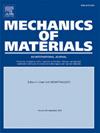On the dynamic JKR adhesion problem
IF 3.4
3区 材料科学
Q2 MATERIALS SCIENCE, MULTIDISCIPLINARY
引用次数: 0
Abstract
Shui et al. (2020) have recently shown that applying high-frequency vibrations, we can increase the mean adhesion between viscoelastic solids. This is due to the fact that oscillating contact area leads to an effect of increased apparent surface energy during the retraction phase which can be described by the well known empirical Gent and Schultz law (GS). However, Shui et al solution surprisingly appears not to depend on GS constants, which would imply perhaps no amplification. Yi et al. (2024) have made similar experiments, and proposed a simpler fitting model, which seems to work however with widely different GS constant when changing the sphere radius. Here, we solve the JKR dynamic adhesion problem for a sphere oscillating on a substrate by imposing an harmonic oscillation of the contact area, which permits to obtain a very simple solution by simply averaging the resulting cycle of indentation. We find that the solution is close to a JKR form for the mean indentation vs mean force, which we find in a simple approximation. Although there is saturation in the amplification when the contact radius shrinks to zero and the problem becomes that of impacts at large amplitudes of vibrations, experiments show that other saturations occurs first, presently unclear. We discuss also the influence of resonances. We find reasonable agreement with experiments conducted on PDMS.
Shui 等人(2020 年)最近的研究表明,应用高频振动可以增加粘弹性固体之间的平均粘附力。这是因为在回缩阶段,摆动的接触面积会导致表观表面能的增加,这可以用众所周知的经验根特和舒尔茨定律(GS)来描述。然而,Shui 等人的解决方案出人意料地似乎并不依赖于 GS 常数,这意味着可能没有放大效应。Yi 等人(2024 年)也做了类似的实验,并提出了一个更简单的拟合模型。在这里,我们通过施加接触面积的谐波振荡来解决球体在基体上振荡时的 JKR 动态粘附问题,这样就可以通过简单地求得压痕周期的平均值来获得非常简单的解决方案。我们发现,平均压痕与平均力的解接近于 JKR 形式,这是我们在简单近似中发现的。虽然当接触半径缩小到零时,放大会出现饱和,问题变成大振幅的冲击,但实验表明,其他饱和会首先出现,目前尚不清楚。我们还讨论了共振的影响。我们发现与在 PDMS 上进行的实验有合理的一致性。
本文章由计算机程序翻译,如有差异,请以英文原文为准。
求助全文
约1分钟内获得全文
求助全文
来源期刊

Mechanics of Materials
工程技术-材料科学:综合
CiteScore
7.60
自引率
5.10%
发文量
243
审稿时长
46 days
期刊介绍:
Mechanics of Materials is a forum for original scientific research on the flow, fracture, and general constitutive behavior of geophysical, geotechnical and technological materials, with balanced coverage of advanced technological and natural materials, with balanced coverage of theoretical, experimental, and field investigations. Of special concern are macroscopic predictions based on microscopic models, identification of microscopic structures from limited overall macroscopic data, experimental and field results that lead to fundamental understanding of the behavior of materials, and coordinated experimental and analytical investigations that culminate in theories with predictive quality.
 求助内容:
求助内容: 应助结果提醒方式:
应助结果提醒方式:


